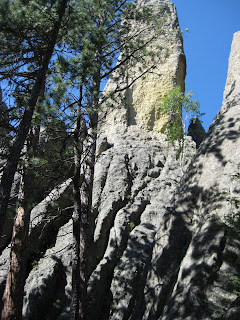Friday, September 26, 2008
Fare thee well
Summer’s come to an end. In four months, I embarked on my first road trip, moved to another state, traded an apartment for a trailer with roommates, turned 32, and spent many, many days being outside – outside working, outside playing. I lived on well under $20 a day, ate more beef in one season than I’ve probably consumed in my life up till this point, learned that trailer living in a hail storm is a hoot, discovered that wildlife majors can’t bowl, went to a $2 movie, tried (and loved!) kuchen, played weekly volleyball, witnessed a bi-annual blasting at Crazy Horse, attempted to catch leopard frogs with nothing but my bare hands and lightning reflexes (yeah, right), became a huge fan of moose meat, startled a moose on a hike, introduced goat curry to a rancher, chased a porcupine, excavated a bison skull, and uncovered a fondness for rodents.
My final nod to South Dakota: Demolition Derby in Rapid City! Then, it’s the 1700+ mile journey back to the northeast.
Thursday, September 25, 2008
He danced in the rain, so we called him Fred…
Our plots are teeming with ferrets. A family of four on Plot #6 inhabits the burrows between traps #21 and #22, which might explain why we haven’t caught the two specific PDs we are targeting in that area.
When I first saw a black-footed ferret, I was amazed at its size… tiny! Also agile, sinuously long and a periscope-like neck as it peeks from the burrow. Ferrets don’t outsize or outweigh prairie dogs, so to kill PDs, they rely on the element of surprise and strike while PDs are asleep during the night. Ferrets have elongated bodies, ideal for living in narrow burrows and they use their bodies to pin PDs to burrow walls during an attack. They kill with a single bite to the neck, which slowly suffocates the PD.
Because PDs can be rather hefty, a black-footed ferret needs to be a highly skilled predator. And they are not always successful – we have caught many PDs with what appear to be ferret-inflicted wounds.
Black-footed ferrets are entirely dependent on PDs to survive – in addition to food, ferrets also live in PD burrows which provide warmth and protection from other predators (badgers and raptors will kill and eat ferrets, while coyotes will kill and bury them – ferrets are not a source of food for coyotes, rather a competitor that coyotes will eliminate opportunistically).
As nocturnal animals, tracking ferrets involves driving around with a spotlight, and keeping a keen eye out for green eyeshine. Ferrets are inherently curious and will often check you out – allowing for some surprising close-ups.
Friday, September 5, 2008
Dead Ferruginous Hawk
Closer than I'll ever get to alive hawk, that's for sure. This beauty was just laying next to a PD burrow on Plot 6. No idea what killed it.
Ferret on Plot 7
Back on the upper plots today, we caught 12 out of the 76 we needed for vaccine boosters and placebos, and many more we didn’t need. We also saw 2 ferrets, 2 prairie rattlesnakes, a burrowing owl, 2 ferruginous hawks – 1 dead with no apparent injuries, and 1 alive and swooping, and a badger. This is why I love working the upper plots. It’s good to be back.
To the Finish Line
Your mission should you choose to accept it is to locate 76 specific prairie dogs and administer vaccine boosters and placebos in the next 10 days before the vaccine expires.
Day #5 in a 15-day work week lived up to its promise to be the first in a series of 10-hour days, as we’ve shrank from a crew of 10 to 4, working 3 plots and 280 traps. Still, I prefer this over vege.
While waiting for the minimum two weeks between administering the vaccine and the booster, we worked a pilot flea & plant study, to see if there was any correlation to the quantity and type of vegetation vs. flea loads on PDs. The theory that was being tested was that colonies with plenty of forage leads to more grooming between prairie dogs, and therefore less fleas. For this study, we had to set up on colonies that had not been dusted for fleas – not an easy find what with the advent of plague in Conata Basin this summer – so that flea counts would not be otherwise affected.
Trapping prairie dogs that have never been trapped before takes persistence and time, which meant shorter easier days, but nothing to show for it sometimes for a week or more. I went from processing 30+ PDs a day to zero. The highest number of captures on a vege plot was a meager 6.
Day #5 in a 15-day work week lived up to its promise to be the first in a series of 10-hour days, as we’ve shrank from a crew of 10 to 4, working 3 plots and 280 traps. Still, I prefer this over vege.
While waiting for the minimum two weeks between administering the vaccine and the booster, we worked a pilot flea & plant study, to see if there was any correlation to the quantity and type of vegetation vs. flea loads on PDs. The theory that was being tested was that colonies with plenty of forage leads to more grooming between prairie dogs, and therefore less fleas. For this study, we had to set up on colonies that had not been dusted for fleas – not an easy find what with the advent of plague in Conata Basin this summer – so that flea counts would not be otherwise affected.
Trapping prairie dogs that have never been trapped before takes persistence and time, which meant shorter easier days, but nothing to show for it sometimes for a week or more. I went from processing 30+ PDs a day to zero. The highest number of captures on a vege plot was a meager 6.
Tuesday, September 2, 2008
Changing Seasons
Two days ago, I was hiking in the Black Hills with a tank top and shorts. Today, I pulled out just about every warm piece of clothing I had as temperatures dipped to 45 degrees. It’s autumn in the Badlands.
Eagle Cliffs
Sunday was a day of rest-ish, with a 4-mile stroll on the limestone plateau of Eagle Cliffs. The day began with kuchen, a custard pie that is South Dakota’s state dessert, and ended with sundaes at Armadillo’s, a new ice cream find in Rapid City.
Amanda Back on the Balance Beam
When Amanda invited me along for a 6-mile loop in Boxelder Creek and Canyon, it sounded like fun. Little did I know that her math was just a tad off. The loop itself was indeed 6.2 miles, but there was quite a ways of walking on the Centennial Trail before reaching the said loop. 16 miles and 9 creek crossings later, needless to say, I’ll be choosing the hikes from here on out.
Black Hills – Yep, One More Time
For the first time this summer, we had an ordinary two-day weekend break just before Labor Day. Returning to Spearfish in the northern Black Hills for more hiking, it was also a weekend spent on feasting!
Hiking in Custer State Park
After some rather pathetic attempts at bouldering, I left Dustin with a pair of rock climbers and spent the rest of my break on more level ground. On my scramble up Little Devil’s Tower, a young blond kid on his way down earnestly told me that there would be ice cream at the top if I persevered.
Needles Eye
Custer State Park in the Black Hills is known for its wild rock formations and obvious appeal to rock climbers.
Crouching Shaman, Hidden Passage
Comic relief from a friend and colleague, Dustin a.k.a. “ferret boy”, the field technician spotlighting black-footed ferrets in the Conata Basin.
Subscribe to:
Comments (Atom)


























